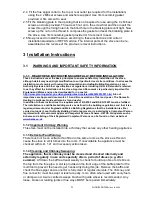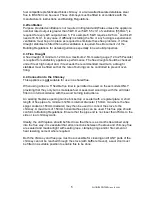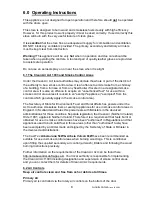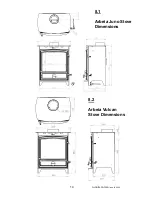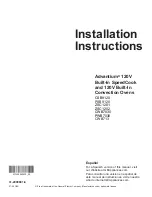
10
Juno & Vulcan
Issue 01 06/13
and will give reliable service without major cleaning or work on the firebox. The liner
boards may require replacement fairly regularly depending upon fuels and the type of
usage experienced. Lining boards are not covered by warranty, as they are a wearing
consumable part.
Baffle:
It is essential to check the top of the baffle for build up of soot and ash regularly
when in use and after a long period of no use. From time to time remove the baffle if
necessary to ensure that the flue way entrance is clear. A slot is provided in the front
edge of the baffle for lifting down with the multi tool for quick and easy checks without
getting dirty hands.
6.4 Fuels
The appliance is fitted with a versatile multifuel grate and the appliance has been tested
and approved burning dry, well-seasoned logs or Ancit smokeless fuel with the optional
solid fuel kit fitted. These are the recommended fuels. For other fuels please contact
the manufacturer for advice. Petroleum coke must never but burnt on this appliance.
6.5 Important Notes for Wood Burning
With a full load of wood, the stove will need to be refuelled approximately every 1.5
hours. Wood can be stacked higher in the stove than solid mineral fuel but care must be
taken that logs do not touch the baffle or the glass panel.
Do not
stack logs above the
level of the tertiary air inlets at the back of the stove.
Wood burns most efficiently with the primary air controls closed and the secondary (air
wash) controls a very small amount open. Carefully adjusting the fuel load and
secondary air controls will then control the burn rate of the stove. Always make sure that
flames are visible above the wood after re-fuelling for cleanest burning.
After re-fuelling
open the air wash full for 3 to 5 minutes or until the logs are fully blackened to
achieve full flames above the fuel.
Wood burns best on a bed of ash and it is therefore only necessary to remove surplus
ash from the stove occasionally.
Burn only dry, well-seasoned wood, which should have been cut, split and stacked -
under protection from rain - for at least 12-24 months with free air movement around the
sides of the stack to enable it to dry out. Burning wet or unseasoned wood will create tar
deposits in the stove and chimney and will not produce a satisfactory heat output.
Wood
that is not properly dry (‘dry’ is considered to be less than 20% internal moisture
content) uses up energy from the burn process to evaporate the water inside the
wood thus creating very poor conditions for combustion
. The main cause of
burning problems with wood stoves is due to excessively damp wood. Wood can appear
perfectly dry on the outside but still contain 40-50% water on the inside. A moisture
meter can be purchased from some stove and equipment suppliers if you wish to check
your wood source is correct.
6.5.1 Refuelling on to a low fire bed
If there is insufficient burning material in the firebed to light a new fuel charge, excessive
smoke emission can occur. Refuelling must be carried out onto a sufficient quantity of
glowing embers and ash so that the new fuel charge will ignite in a reasonable period. If
there are too few embers in the fire bed, add suitable kindling to prevent excessive
smoke.
6.5.2 Fuel overloading
The maximum amount of fuel specified in this manual should not be exceeded,
overloading can cause excess smoke.




